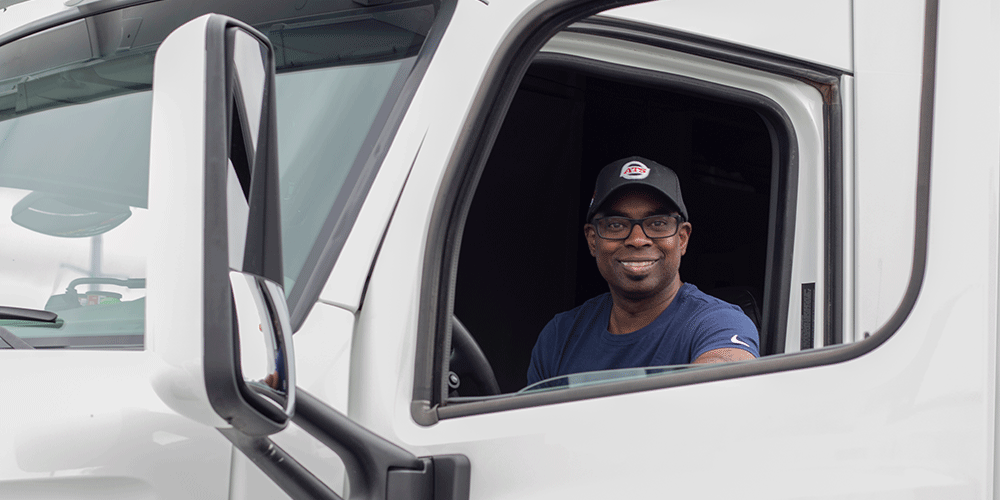Truck Driver Hiring & Orientation: What to Expect in 2025
With over 7 years of experience in the transportation industry, John is a leading driver consultant on the ATS team. His focus is to find high-quality, professional, safe drivers – whether they are independent contractors or company drivers employed with ATS.
Are you thinking about becoming a truck driver, but unsure what to expect from the truck driver hiring process? You’re not alone. Many new drivers wonder:
- Will there be a formal interview?
- What kind of background checks do CDL companies run?
- What happens during orientation?
At Anderson Trucking Service (ATS), we do our best to ensure new drivers feel fully informed before they head to orientation. With that said, there's only one way to guarantee all your questions get answered: by asking them.
Over our 70 years of experience in the industry, ATS has set countless drivers up for success by answering questions with transparency, prioritizing clear communication, and setting the right expectations up front.
We're happy to help you succeed, too — which is why we've created this guide. This article will walk you through the entire process, from CDL application to your driver orientation, so you can approach your job search with confidence in 2025 and beyond. At the end of the article, you'll find a free truck driver orientation checklist of documentation to bring and expectations to have heading into your orientation.
Truck Driving Job Requirements
In general, truck driving jobs have both an educational and licensing component. Before you even fill out an application to drive for a trucking carrier, you must have either a high school diploma or a GED. You must also earn your Commercial Driver's License (CDL).
There are several additional requirements you must meet to get your CDL, including an age minimum of 21 to drive outside your licensing state. (While you can get your CDL at 18, you can only driver intrastate.) Other CDL requirements include:
- A current, valid state driver's license
- Written test
- Skills test
- Vision test
- Road skills test
Requirements vary by state, so be sure to look up the specifics for your area. To pass the testing components, most aspiring drivers enroll in trucking school.
Trucking school may cost thousands of dollars and last several weeks. During trucking school, students take classroom courses and participate in hands-on learning to prepare for their CDL tests.
If you're interested in hauling specific, specialized freight (like hazardous materials) or drive certain equipment (like a tanker), you may be required to obtain additional CDL endorsements.

Are There Truck Driving Jobs with No Experience Required?
The question of experience looms large for many new CDL drivers. But there's good news: you can get a job as a truck driver without any professional experience behind the wheel of a truck.
After you graduate from your trucking school program, your next task will be finding a trucking company that will hire you with no experience.
Some companies will even offer CDL training programs or sponsor your trucking school enrollment if you can't afford to attend without financial assistance.
You may have to complete an in-house training program or "driver finishing program" before you can get started with a company.
Like trucking school, those courses may also last several weeks. But it will be time well spent, as you'll learn everything you need to know about your new company, their policies and processes, their equipment, and safety regulations.
While some companies will work with drivers fresh out of trucking school, others (like ATS) have minimum experience requirements. These companies typically require several months to a year of over-the-road (OTR) driving experience before you are eligible to drive for them.
The bottom line? Do your research before you start applying — or even before you start studying for your CDL, if you're interested in working for a carrier that will help pay for your schooling.
How to Apply for CDL Trucking Jobs
Once you’ve earned your CDL and found companies that fit your experience level, you can start the application process.
Most applications begin online with a simple information request. From there, a recruiter will usually reach out quickly — sometimes even the same day — to explain the company’s driving program and ask you a few questions. This is the start of the interview process.
Recruiters will want to know your background and goals, but you should also come prepared with your own questions. Pay is important, but don’t forget to ask about home time, equipment, training, and long-term opportunities. The more you know up front, the less likely it is you’ll be surprised later.
If you’re new to trucking, lean on recruiters and other drivers you know. There are no "dumb questions" here, and the best way to find the right fit is by asking everything that’s on your mind. Some drivers apply after one conversation, while others take weeks or months to decide — both are normal.
Before you pick up the phone, it can also help to brush up on trucking terms, so you feel confident in the conversation.
Above all, be open and honest with recruiters about what you’re looking for. They can only match you with the right job if they clearly understand your priorities.
Once you’ve determined that a trucking company is the right fit for you, it’s time for you to fill out an application. Applications vary from company to company, but they will all require you to provide enough personal information to perform the necessary background checks.

Truck Driver Background Check Explained
The information in your application will be used by recruiters and a safety team to run background checks. To qualify, you’ll need a valid CDL, authorization to operate commercial vehicles, and to meet physical and employment requirements.
Every trucking company has its own standards, but most will review:
- Truck abandonment history
- Terminations from past jobs
- Travel restrictions
- Job changes
- Motor Vehicle Record (MVR)
- Drive-A-Check (DAC) Report
- Pre-Employment Screening Program (PSP) results
- Compliance, Safety, Accountability (CSA) score
- Criminal background
- Consumer report
It’s a thorough process designed to ensure you’re both qualified and safe. Too many job changes, a poor CSA score, or negative history with previous employers can prevent your application from moving forward.
Most companies respond within 24 hours with either an approval, a rejection, or a request for more information. In some cases, recruiters may advise you to reapply later — for example, once you gain more driving experience or after a violation falls off your record.
Reputable carriers set high standards because safety matters. Strong records not only keep you and other drivers safe but also allow companies to book better freight — which ultimately means more pay in your pocket.
What to Expect After Your Application Is Accepted
Once you’re approved, it’s time to give notice at your current job (if needed), schedule orientation, and arrange travel.
This stage offers a first look at how a company treats its drivers. Some carriers cover travel, hotels, and meals, while others offer less or nothing at all. Research this ahead of time — a company’s approach here says a lot about how they value drivers.
Stay in touch with your recruiter as orientation approaches. Questions often come up, and they’ll be your best resource for clear answers.
Orientation Basics
Orientation usually lasts a few days. Some carriers handle parts of it virtually, but DOT regulations require every driver to attend orientation. Expect to complete paperwork, drug testing, a physical (if you don’t already have a med card), and training on safety and hours of service.
You’ll likely take a road test, practice load securement, and sit through sessions on company values, contracts, permits, communication, and expectations. You’ll also meet your driver manager and other key staff.

When You're Officially Hired
You’re not fully hired until orientation is complete, your certification is issued, and your contract is signed. Orientation is essentially part of the interview — failing a drug test, a poor DAC report, or misaligned expectations can end the process.
Getting Your Truck
At the end of orientation, you’ll be assigned a truck. Some carriers let you choose from different brands and expect you to inspect it closely. If you’ll be dispatched right away, bring supplies to live out of the truck for a few days, along with all necessary documents for payroll and employment.
Truck Driver Orientation Checklist
Bring these items and be ready for the following steps so your truck driver orientation goes smoothly and successfully:
Documents & Paperwork
- Valid CDL and driver's license
- Medical card (if you already have one)
- Social Security card or proof of work eligibility
- Direct deposit information
- Any training certificates or endorsements
Personal Essentials
- Clothing and toiletries for several days
- Personal items like a pillow, extra blanket, etc.
- Food, snacks, and spending money for travel
- Supplies to live out of your truck for a few days, if dispatched right after orientation
Not sure whether you'll be expected to hit the road immediately from orientation? That's one of the questions you should ask when talking with your recruiter.
What to Expect During Orientation
- Paperwork and onboarding sessions
- DOT-required drug test and physical (if needed)
- Road test and securement training
- Safety, hours of service, and company policy training
- Meeting your driver manager and company staff
- Truck assignment and inspection
Ultimately, you should treat orientation like part of the interview process — because it is. Come prepared, ask questions, and make sure the company feels like the right fit for you.
Start Your Truck Driving Job with Confidence
Beginning your journey as a new truck driver can feel overwhelming, but understanding the CDL hiring process, background checks, and orientation requirements takes much of the uncertainty out of the journey.
By knowing what to expect — from your first recruiter conversation to signing your contract — you’ll be better prepared to choose the right carrier, ask the right questions, and set yourself up for long-term success. With the right preparation, you’ll walk in confident, avoid surprises, and leave ready to hit the road.
Want even more tips? Read our guide How to Have a Smooth Truck Driver Orientation Experience: 8 Tips for more practical advice you can use to make orientation stress-free and successful.

